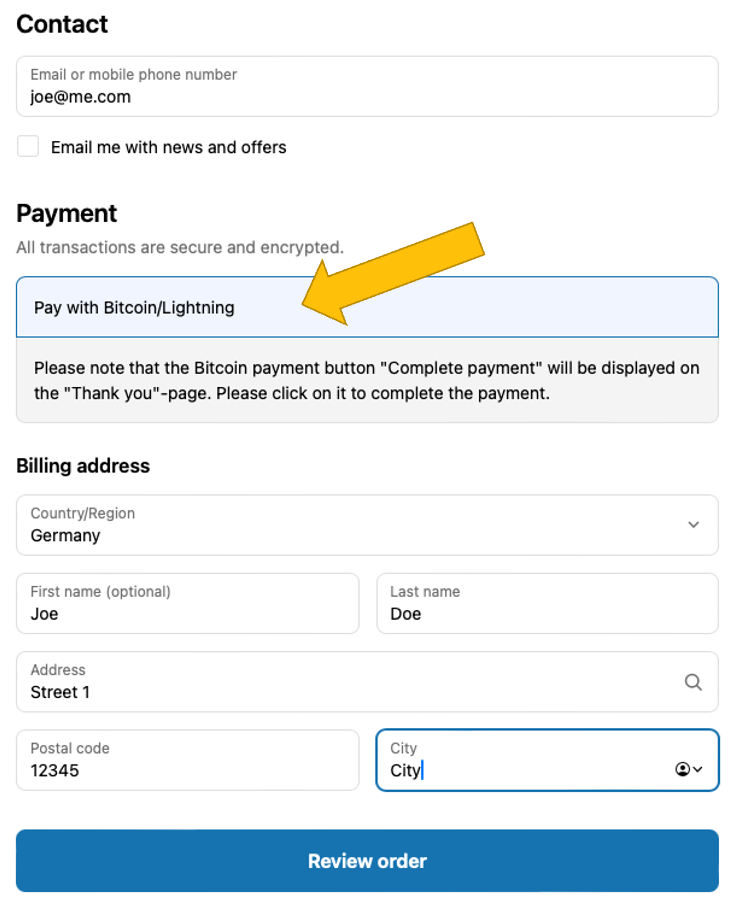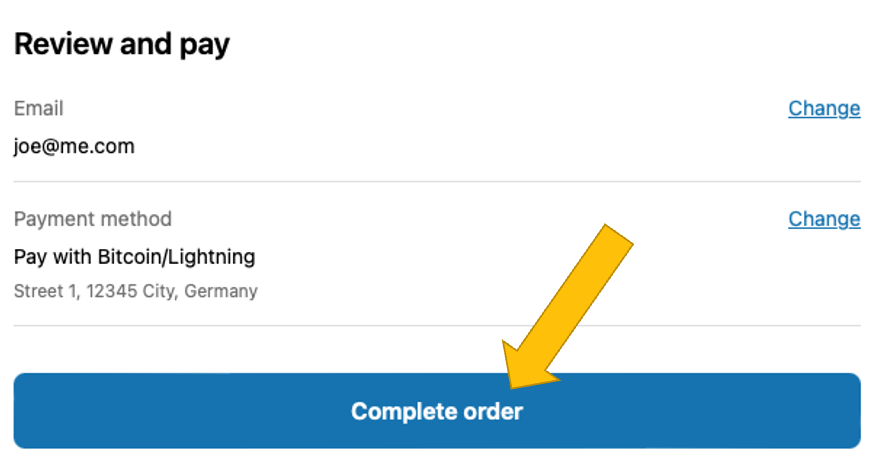Accept Bitcoin payments in Shopify – here’s how!

Shopify is one of the world’s leading e-commerce platforms today. About 4.5 million active online stores in more than 175 countries rely on the Canadian company, which is characterized by user-friendliness, scalability and a huge selection of extensions. From small creative stores to medium-sized brands and international wholesalers – Shopify is the backbone of countless digital business models.
As money and payment flows are digitized, interest in Bitcoin as a means of payment is growing – not only among tech-savvy customers, but also in the mainstream. For Shopify merchants, the integration of Bitcoin payments means:
- Global solvency without currency barriers
- Lower transaction costs compared to traditional payment service providers
- Protection against chargebacks
- Access to a growing, solvent Bitcoin community
- Innovative brand image through openness to modern technologies
Despite these advantages, Shopify does not offer native support for Bitcoin in the checkout – there is neither Shopify Lightning Payment nor Shopify Bitcoin Payment. However, there are now simple solutions that allow you to accept Bitcoin payments in Shopify: With providers such as Coinsnap, you can now accept Bitcoin payments in Shopify without any coding knowledge(see below).
In this article, we’ll show you how you can integrate Bitcoin payments into your Shopify store, what tools are available and what you should look out for.

Status quo: Accepting Bitcoin payments in Shopify
Shopify Payments (only available in certain countries)
- Shopify’s own payment platform
- Accepts credit cards (Visa, MasterCard, Amex, etc.)
- Accepts Apple Pay, Google Pay, Klarna, iDEAL, Sofortüberweisung and many more.
- No third-party account necessary
External payment providers
Shopify supports hundreds of third-party providers – depending on the region. Examples:
- PayPal
- Amazon Pay
- Stripe
- Mollie
- Adyen
- Skrill
- 2Checkout
Alternative payment providers
- Cryptocurrencies (via third-party providers – see provider overview below)
- Bank transfer
- Cash on delivery
- Payment on account
- User-defined manual methods
Shopify currently does not offer a native or official solution for Bitcoin in the regular checkout! Therefore, Shopify merchants who want to accept Bitcoin payments in Shopify are dependent on an alternative payment method that they have to implement themselves.
However, one advantage of the “alternative payment method” Bitcoin Lightning Payment is that Shopify – in contrast to Shopify Payment, for example – does not charge any fees on sales generated with Bitcoin Lightning.
Provider overview: Accept Bitcoin payments in Shopify
There are now various providers that enable Bitcoin payment in Shopify as an alternative payment method. Here is a selection of the most popular solutions:
| Provider | Lightning | On-chain | Shopify-compatible | Special feature |
| Coinsnap | + | + | + (via proxy/app) | No KYC Direct payout to wallet Simple DIY Free Shopify integration service available Payout in fiat to bank account possible |
| BTCPay Server | + | + | + (custom) | Open Source No fees |
| CoinBase Commerce | – | + | + (manual) | KYC required |
| OpenNode | + | + | + (API/Widget) | Payout in fiat possible |
| Flash | + | – | + (manual) | No KYC Installation only possible with Flash support team |
Important selection criteria for merchants
Firstly, setting up the Bitcoin payment method in Shopify shouldn’t overwhelm you. If you are a Shopify and Lightning pro, BTCPay Server is certainly worth considering.
However, if you are a “normal” Shopify user and do not have in-depth programming knowledge, you should take a closer look at Bitcoin payment providers such as Coinsnap, which offer payment processing from a single source and actively help you set up the payment method or even take care of it completely if you wish.
Another selection criterion is the well-known, often tiresome topic of KYC – Know your Customer. KYC means that you have to submit a wealth of information to the provider, which a) can turn into a bureaucratic nightmare and b) can cost valuable time, as the provider has to check your documents and you may even have to submit additional documents.
Other selection criteria include the time at which customer payments are credited (immediately, at a certain frequency, when certain thresholds are reached). Of course, it is ideal for you as a merchant if your customers’ payments are credited to your wallet immediately.
And the question of whether the provider supports Lightning, on-chain or both can also be an important decision criterion. For example, if you sell high-priced products (over €1,000), you need on-chain. For low-priced products, on the other hand, Lightning is best, as it is faster and cheaper than on-chain.
How does shopping with Bitcoin in Shopify work?
From the customer’s perspective, shopping with Bitcoin in Shopify is just as easy as with the other payment methods and is initiated directly in the checkout. However, instead of a form, e.g. for credit card details, the user sees a QR code when paying with Bitcoin.
This is how shopping with Bitcoin works with Coinsnap, for example:
After your customer has made their selection and clicked on “Checkout”, they will see the checkout form. Here they enter their personal details and shipping information and select the Pay with Bitcoin/Lightning option. Next, they must click on Review order.

The Review and pay page then appears. If everything is O, your customer clicks on Complete order.


QR code for Bitcoin payment in Shopify
The actual Bitcoin payment window now opens and the customer can pay with Bitcoin Lightning by scanning the QR code and authorizing the transaction in their Bitcoin Lightning wallet
After successful payment, the customer receives a notification that the payment has been successfully completed.
During the order and payment process, the customer is informed by e-mail about the status of his order.
The customer receives the first notification by e-mail after the order has been successfully placed and a further notification after the payment has been successfully completed. At the same time, the order is set to ‘paid’ in the Shopify system so that the shop operator can initiate the next steps (e.g. dispatch).
The example shows how user-friendly and easy it is for your customers to pay with Bitcoin if they have a Lightning Wallet.
Why do you want a third-party provider to integrate Bitcoin payment into Shopify?
The pitfalls of closed systems
A key aspect of integrating Bitcoin payments into Shopify is the closed architecture of the system. Although Shopify allows you to integrate alternative payment methods, it does not offer complete freedom in the design of the checkout process.
Native crypto payments such as Bitcoin or Lightning are not supported in the regular checkout flow, but must be integrated via the interface provided by Shopify for alternative payment providers or via so-called app proxies .
This means that the actual payment is made outside of the Shopify checkout – for example on an external page or via an embedded QR code as shown above.
So if you want to integrate Bitcoin payments, you have to use technical workarounds, for example by using payment widgets, webhooks, app proxies or payment redirects. The manual payment method (“Custom Payment Method”) can also be used, but without automatic payment confirmation. In any case, independent integration requires considerable technical understanding.
The advantages of alternative Bitcoin payment providers
Alternatively, there are various payment providers that offer solutions specially optimized for Shopify. These have solved the challenges described above in an application (app or cloud solution) and make this available to you for a small fee (e.g. 1% of the payment amount with Coinsnap).
We will now show you how easy such third-party payment providers can make it for you to accept Bitcoin payments in Shopify, using Coinsnap as an example.
Accept Bitcoin payments in Shopify in 3 steps with Coinsnap
Coinsnap is a European provider of plugins and apps for processing Bitcoin Lightning payments. The company’s aim is to make it particularly easy and hassle-free for merchants to accept Bitcoin Lightning payments in their online stores and on site.
In the case of Shopify, Coinsnap makes it particularly easy for you by offering a free integration service. There you can see how you can accept Bitcoin payments in your Shopify store in just 3 steps:
1. set up a Coinsnap account
Go to Register on coinsnap.io, enter your email address, set a password and click Create Account. (If you have one, enter a referral code to save 0.25% percentage points on transaction fees). Then confirm your account by clicking on the link in the email you received from Coinsnap.
When you are in your account, enter the name of your online store and your Lightning Wallet address. And you have an active Coinsnap account.
2. set up Shopify admin for Coinsnap
Now go to Settings and click on Shopify in the blue box. Now select the Request an Installation Service option. Then open this document and follow the instructions on how to set up a Shopify admin for Coinsnap in your Shopify backend. This is very easy and can be done in a few minutes.

3. Start free Shopify integration
Then go back to your Coinsnap dashboard, activate the two checkboxes and click on the Start installation button.
Now the Coinsnap technicians will take over for a short time and set up Coinsnap and Shopify so that your store offers the Bitcoin/Lightning payment option and all sales are credited directly to your Lightning wallet.
The example of Coinsnap for Shopify shows that the complexity of Shopify and the blockchain are no longer an obstacle to accepting Bitcoin payments in your Shopify store.
Conclusion: Accepting Bitcoin payments in Shopify has never been easier
Shopify allows the integration of Bitcoin payments, but not as a native checkout method. Instead, you need to use third-party providers such as Coinsnap or BTCPay Server to offer Bitcoin payments securely and easily.
However, since Shopify is a closed system, the integration of Bitcoin is not easy. It is therefore a great advantage for Shopify merchants that there are now solutions such as Coinsnap for Shopify, which provide the payment infrastructure and only need to be linked to Shopify.
The merchant should therefore make sure to choose a Bitcoin payment provider for their Shopify that provides detailed, step-by-step instructions for integrating their solution with Shopify, or ideally offers a free integration service.
With such a solution, you will be able to accept Bitcoin payments in Shopify tomorrow without any programming knowledge!
Questions & answers about accepting Bitcoin payments in Shopify
❓ Is it legal to offer Bitcoin payments in my Shopify store?
Yes, it is perfectly legal in most countries. The important thing is that you record the revenue properly in your accounting and declare and pay taxes correctly – as with other payment methods.
❓ Does my customer have to have a Lightning wallet?
Not necessarily. Some payment providers (such as Coinsnap) support both Lightning and on-chain Bitcoin payments. However, Lightning is significantly faster and cheaper for small amounts.
❓ Can I automatically convert Bitcoin payments into euros or dollars?
That depends on the provider. Coinsnap transfers directly to your wallet in BTC/Sats, but also directly to your bank account in FIAT if you wish.
❓ How does the customer find out that the payment was successful?
Payment providers such as Coinsnap display a confirmation after a successful payment and redirect the customer back to the store if necessary. The customer also receives email notifications (e.g. order confirmation) from the Shopify system.
❓ What happens if the payment fails or is canceled?
In this case, the order is marked as “pending” or “not completed” in Shopify – the merchant always sees whether a payment has been completed or not.
❓ How are Bitcoin payments recorded in the accounts?
In most countries, they are regarded as non-cash or cash proceeds. The equivalent value in euros at the time of payment must be documented. Coinsnap, for example, offers you a link to CoinTracking on request so that your Bitcoin sales are automatically recorded in a legally compliant manner for tax purposes.
Mistakes you should avoid if you want to accept Bitcoin payments in Shopify
🚫 Only offer on-chain payments
Many customers want to pay quickly and cheaply. Lightning is ideal for small amounts (e.g. under €100). Avoid on-chain-only offers if you have low shopping baskets.
🚫 Do not back up your wallet
Make sure that you regularly back up your Lightning or Bitcoin wallet. Lost wallet = lost income!
🚫 Choose providers without Shopify experience
Many Bitcoin payment providers are technically optimized, but not for Shopify. Use services like Coinsnap that offer specific Shopify integrations and even installation help.
🚫 Do not advertise the payment method
Do not hide Bitcoin anywhere in the checkout. Use banners, footer hints or even discounts (“Pay with Bitcoin and get a 5% discount”) to attract attention.
🚫 Ignore legal requirements
In some countries, for example, you need to issue correct invoices in euros or register with the tax office. Find out in advance or consult a tax advisor.
Accept Bitcoin payments in Shopify now
Accepting Bitcoin payments in Shopify has never been easier than with the Coinsnap for Shopify app. Thanks to the hassle-free registration with Coinsnap and the free Shopify installation service from Coinsnap, you can start installing the Bitcoin payment method in your Shopify store in just a few minutes.
All you need is a Coinsnap account, create an admin for Coinsnap in your Shopify store and start the free installation service with one click:














